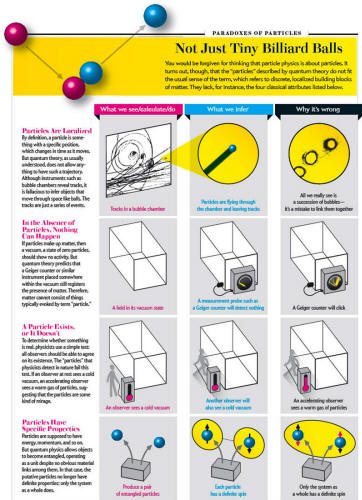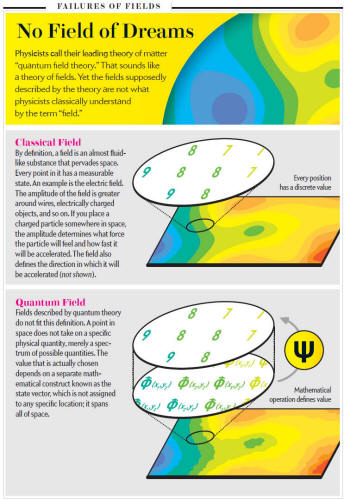|
|
|
Scientific American (August 2013) 309, 40-47 from Nature Website
Whether the World Is Made of Particles or Fields... or Something Else Entirely.
Physicists speak of the world as being made of particles and force fields, but it is not at all clear what particles and force fields actually are in the quantum realm. The world may instead consist of bundles of properties, such as color and shape
In Brief
Physicists routinely describe the universe as being made of tiny subatomic particles that push and pull on one another by means of force fields.
They call their subject "particle physics" and their instruments "particle accelerators." They hew to a Lego-like model of the world. But this view sweeps a little-known fact under the rug:
The problem is not that physicists lack a valid theory of the subatomic realm.
They do have one: it is called quantum field theory.
Theorists developed it between the late 1920s and early 1950s by merging the earlier theory of quantum mechanics with Einstein's special theory of relativity. Quantum field theory provides the conceptual underpinnings of the Standard Model of particle physics, which describes the fundamental building blocks of matter and their interactions in one common framework.
In terms of empirical precision, it is
the most successful theory in the history of science. Physicists use
it every day to calculate the aftermath of particle collisions, the
synthesis of matter in the big bang, the extreme conditions inside
atomic nuclei, and much besides.
The unsettled interpretation of quantum
field theory is hobbling progress toward probing whatever physics
lies beyond the Standard Model, such as string theory. It is
perilous to formulate a new theory when we do not understand the
theory we already have.
However compelling it might appear, it
is not at all satisfactory.
Debate has swirled over this point - over whether quantum field theory is ultimately about particles or about fields. It started as a battle of titans, with eminent physicists and philosophers on both sides.
Even today both concepts are still in
use for illustrative purposes, although most physicists would admit
that the classical conceptions do not match what the theory says. If
the mental images conjured up by the words "particle" and "field" do
not match what the theory says, physicists and philosophers must
figure out what to put in their place.
They suggest that the most basic constituents of the material world are intangible entities such as relations or properties. One particularly radical idea is that everything can be reduced to intangibles alone, without any reference to individual things.
It is a counterintuitive and
revolutionary idea, but some argue that physics is forcing it on us.
Several overlapping lines of thought
make it clear that the core units of quantum field theory do not
behave like billiard balls at all.
Caveat: Some minority
interpretations of quantum physics do think in terms of well-defined
trajectories. But they suffer from their own difficulties, and I
stick to the standard view - see "Bohm's
Alternative to Quantum Mechanics," by David Z Albert; May
1994.
We think of particles as tiny billiard balls, but the things that modern physicists call "particles" are nothing like that. According to quantum field theory, objects cannot be localized in any finite region of space, no matter how large or fuzzy it is. Moreover, the number of the putative particles depends on the state of motion of the observer.
All these results taken together sound
the death knell for the idea that nature is composed of anything
akin to ball-like particles.
One may adopt the phrase "quantum particle," but what justifies the use of the word "particle" if almost nothing of the classical notion of particles has survived?
It is better to bite the bullet and abandon the concept altogether. Some take these difficulties as indirect evidence for a pure field interpretation of quantum field theory. By this reasoning, particles are ripples in a field that fills space like an invisible fluid.
Yet as we will see now, quantum field
theory cannot be readily interpreted in terms of fields, either.
The Trouble with
Fields
But what is a "quantum version"? The
term "field" conjures up magnetic fields that cause iron filings to
align themselves around a bar magnet and electric fields that cause
hair to stand up on end, but a quantum field is so different from a
classical one that even theoretical physicists admit they can barely
visualize it.
A quantum field instead assigns abstract
mathematical entities, which represent the type of measurements you
could conduct, rather than the result you would obtain. Some
mathematical constructions in the theory do represent physical
values, but these cannot be assigned to points in space-time, only
to smeared-out regions.
Operators place a layer of abstraction between the theory and reality. A classical field is like a weather map that shows the temperature in various cities. The quantum version is like a weather map that does not show you "40 degrees," but "√."
To obtain an actual temperature value,
you would need to go through an extra step of applying the operator
to another mathematical entity, known as a state vector, which
represents the configuration of the system in question.
Quantum mechanics - the theory on which quantum field
theory is based - does not traffic in determinate values either but
only in probabilities. Ontologically, though, the situation seems
weirder in quantum field theory because the supposedly fundamental
entities, the quantum fields, do not even specify any probabilities;
for that, they must be combined with the state vector.
A classical field lets you envision
phenomena such as light as propagation of waves across space. The
quantum field takes away this picture and leaves us at a loss to say
how the world works.
A common response is that particles and fields should be seen as complementary aspects of reality. But that characterization does not help, because neither of these conceptions works even in those cases where we are supposed to see one or the other aspect in purity.
Fortunately, the particle and field
views do not exhaust the possible
ontologies for quantum field
theory.
Structures to the
Rescue?
Such a view breaks with traditional
atomistic or pointillist conceptions of the material world in a more
radical way than even the severest modifications of particle and
field ontologies could do.
Take the example of mass. Do you ever see mass itself? No. You see only what it means for other entities or, concretely, how one massive body is related to another massive body through the local gravitational field.
The structure of the world, reflecting
how things are interrelated, is the most enduring part of physics
theories. New theories may overturn our conception of the basic
building blocks of the world, but they tend to preserve the
structures. That is how scientists can make progress.
This leap makes structural realism a
more radical proposition, called
ontic structural realism.
By analogy, consider a mirror-symmetric face.
A mirror swaps the left eye for the right eye, the left nostril for the right, and so on. Yet all the relative positions of facial features remain. Those relations are what truly define a face, whereas labels such as "left" and "right" depend on your vantage point.
The things we have been calling "particles" and "fields" possess more abstract symmetries, but the idea is the same.
CREDIT: Travis Rathbone;
PROP STYLING BY SARAH
GUIDO
In this case, you can construct a
perfectly valid theory by positing the existence of specific
relations without additionally assuming individual things. So
proponents of ontic structural realism say we might as well dispense
with things and assume that the world is made of structures, or nets
of relations.
In London, St. Paul's is directly connected to Holborn, whereas from Blackfriars you need to change lines at least once, even though Blackfriars is closer to Holborn than St. Paul's. It is the structure of the connections that matters primarily.
The fact that Blackfriars Tube station
has recently been renovated into a nice new station does not matter
to someone trying to navigate the system.
All the intrinsic properties of the two particles, such as electrical charge, together with all their extrinsic properties, such as position, still do not determine the state of the two-particle system. The whole is more than the sum of its parts.
The atomistic picture of the world, in
which everything is determined by the properties of the most
elementary building blocks and how they are related in space-time,
breaks down. Instead of considering particles primary and
entanglement secondary, perhaps we should think about it the other
way round.
It sounds like having a marriage without spouses. You are not alone. Many physicists and philosophers find it bizarre, too, thinking it impossible to get solid objects merely on the basis of relations.
Some proponents of ontic structural realism try to compromise.
They do not deny objects exist; they merely claim that relations, or structures, are ontologically primary. In other words, objects do not have intrinsic properties, only properties that come from their relations with other objects.
But this position seems wishy-washy. Anyone would agree that objects have relations. The only interesting and new position would be that everything emerges purely on the basis of relations.
All in all, structural realism is a
provocative idea but needs to be developed further before we will
know whether it can rescue us from our interpretive trouble.
Bundles of Properties
Although the particle and field interpretations are traditionally considered to be radically different from each other, they have something crucial in common. Both assume that the fundamental items of the material world are persistent individual entities to which properties can be ascribed.
These entities are either particles or, in the case of field theory, space-time points.
Many philosophers, including me, think
this division into objects and properties may be the deep reason why
the particle and field approaches both run into difficulties. We
think it would be better to view properties as the one and only
fundamental category.
For instance, when you think of red, you usually think of particular red things and not of some freely floating item called "redness."
But you could invert this way of
thinking. You can regard properties as having an existence,
independently of objects that possess them. Properties may be what
philosophers call "particulars" - concrete, individual entities.
What we commonly call a thing may be just a bundle of properties:
color, shape, consistency, and so on.
It sounds a bit funny, and unfortunately
the term brings inappropriate connotations with it, but it is
established by now.
What we perceive is a round shape, some shade of red, with a certain elastic touch. Only later we do associate this bundle of perceptions with a coherent object of a certain kind - namely, a ball.
Next time we see a ball, we essentially
say, "Look, a ball," and forget how much conceptual apparatus is
involved in this seemingly immediate perception.
The behavior of the vacuum in quantum
field theory is particularly mind-boggling: the average value of the
number of particles is zero, yet the vacuum seethes with activity.
Countless processes take place all the time, involving the creation
and subsequent destruction of all kinds of particles.
A particle is what you get when those
properties bundle themselves together in a certain way.
Physics and
Metaphysics
The answer is straightforward. Although the theory tells us what we can measure, it speaks in riddles when it comes to the nature of whatever entities give rise to our observations.
The theory accounts for our observations
in terms of quarks, muons, photons and sundry quantum fields, but it
does not tell us what a photon or a quantum field really is. And it
does not need to, because theories of physics can be empirically
valid largely without settling such metaphysical questions.
For them, theories are only instruments for making experimental predictions. Still, most scientists have the strong intuition that their theories do depict at least some aspects of nature as it is before we make a measurement.
After all, why else do science, if not
to understand the world?
Metaphysics supplies various competing frameworks for the ontology of the material world, although beyond questions of internal consistency, it cannot decide among them.
Physics, for its part, lacks a coherent
account of fundamental issues, such as the definition of objects,
the role of individuality, the status of properties, the relation of
things and properties, and the significance of space and time.
Metaphysical thinking guided Isaac Newton and Albert Einstein, and it is influencing many of those who are trying to unify quantum field theory with Einstein's theory of gravitation.
Philosophers have written libraries full of books and papers about quantum mechanics and gravity theory, whereas we are only beginning to explore the reality embodied in quantum field theory.
The alternatives to the standard particle and field views that we are developing may inspire physicists in their struggle to achieve the grand unification.
|




